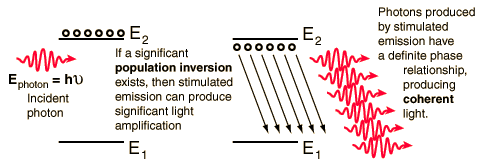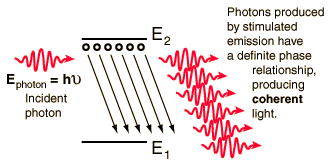Parallel Light from a Laser
The light from a typical laser emerges in an extremely thin beam with very little divergence. Another way of saying this is that the beam is highly "collimated". An ordinary laboratory helium-neon laser can be swept around the room and the red spot on the back wall seems about the same size at that on a nearby wall.

The high degree of collimation arises from the fact that the cavity of the laser has very nearly parallel front and back mirrors which constrain the final laser beam to a path which is perpendicular to those mirrors. The back mirror is made almost perfectly reflecting while the front mirror is about 99% reflecting, letting out about 1% of the beam. This 1% is the output beam which you see. But the light has passed back and forth between the mirrors many times in order to gain intensity by the stimulated emission of more photons at the same wavelength. If the light is the slightest bit off axis, it will be lost from the beam.
The highly collimated nature of the laser beam contributes both to its danger and to its usefulness. You should never look directly into a laser beam, because the highly parallel beams can focus to an almost microscopic dot on the retina of your eye, causing almost instant damage to the retina. On the other hand, this capacity for sharp focusing contributes to the both the medical applications and the industrial applications of the laser. In medicine it is used as a sharp scalpel and in industry as a fast, powerful and computer-controllable cutting tool.
|




